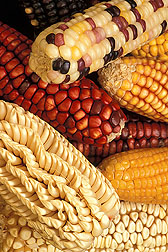Washington, DC, USA
September 9, 2010
 U.S. Department of Agriculture (USDA) scientists are tapping into the genetic diversity of corn from the tropics to improve varieties grown in the United States and other temperate regions.
U.S. Department of Agriculture (USDA) scientists are tapping into the genetic diversity of corn from the tropics to improve varieties grown in the United States and other temperate regions.
Corn, or maize, can be traced to tropical Latin America, where the plants flower as the days grow shorter. As maize was carried from tropical to temperate regions, it had to adapt to the longer day lengths found during temperate summers, according to Jim Holland, an Agricultural Research Service (ARS) plant geneticist at the agency's Plant Science Research Unit in Raleigh, N.C. ARS is USDA's principal intramural scientific research agency.
The genetic diversity of tropical maize could be used to improve maize varieties in temperate regions. But because tropical varieties flower very late when grown under long day lengths in temperate climates, undesirable traits such as poor yield can mask favorable traits such as disease resistance, according to Holland.
Holland and his team crossed two tropical, photosensitive maize lines—one from Mexico, the other from Thailand—with two temperate maize lines found in the United States to assess how day length would affect flowering time in the offspring. The lines were added to a collection developed by Holland and other ARS scientists who crossed a commonly studied corn variety with 25 diverse lines and repeatedly self-fertilized the offspring to create 5,000 inbred lines, each with a unique combination of traits. The collection has become a powerful and widely used tool in the search for genes to enhance desirable traits in maize.
Through genetic mapping, Holland's team identified four regions, or quantitative trait loci (QTLs), in the maize genome associated with photoperiod sensitivity. The QTLs—named ZmPR1-4 by the researchers—represent 2 percent of the genetic map, showing that the scientists sufficiently narrowed the genome to pinpoint four specific areas.
The results, published in Genetics, will help researchers select for genes in hardy tropical varieties that could make them better adapted to the long day lengths of temperate regions. They may also help U.S. breeders develop corn varieties that offer increased yields, disease resistance and other desired traits.
Read more about this and other research to improve corn in the September 2010 issue of Agricultural Research magazine.
This research supports the USDA priority of promoting international food security.
Maize specimens from the ARS germplasm collection. Photo by Keith Weller.
Utilizando la diversidad genética del maíz tropical para mejorar variedades estadounidenses
Científicos del Servicio de Investigación Agrícola (ARS) están utilizando la diversidad genética del maíz de las regiones tropicales para mejorar las variedades cultivadas en EE.UU. y otras regiones templadas.
Se puede seguir la pista de los orígenes del maíz a las regiones tropicales de Latinoamérica, donde las plantas florecen cuando se acortan los días. Con el movimiento del maíz desde las regiones tropicales hasta las regiones templadas, la planta tuvo que adaptarse a los días más largos durante el verano en las regiones templadas, según Jim Holland, quien es genetista de plantas con la Unidad de Investigación de la Ciencia de Plantas mantenida por el ARS en Raleigh, Carolina del Norte. ARS es la agencia principal de investigaciones científicas del Departamento de Agricultura de EE.UU. (USDA por sus siglas en inglés).
La diversidad genética del maíz tropical podría ser útil en mejorar variedades de maíz en las regiones templadas. Pero ya que las variedades tropicales florecen muy tarde cuando cultivadas en un clima templado con días más largos, los rasgos no deseables tales como reducciones en rendimientos podrían enmascarar rasgos deseables tales como resistencia a enfermedades, según Holland.
Holland y sus colegas cruzaron dos líneas fotosensibles de maíz tropical—una de México, otra de Tailandia—con dos líneas de maíz de EE.UU. para evaluar cómo la duración del día podría afectar el florecimiento en la progenie.
Esas líneas se agregaron a una colección desarrollada por Holland y otros científicos del ARS. Los científicos luego cruzaron una variedad ampliamente estudiada con 25 líneas diversas, y repetidamente autopolinizaron las progenies para crear 5.000 líneas endogámicas, cada una con una combinación única de rasgos. La colección ha llegado a ser una herramienta poderosa y ampliamente usada en la búsqueda para genes que podrían ser útiles en aumentar los rasgos deseables en maíz.
Con la creación de mapas genéticos, Holland y sus colegas identificaron cuatro regiones, conocidas como locis de rasgos cuantitativos (QTLs), en el genoma de maíz que tienen un papel en la sensibilidad al fotoperíodo. Estos QTLs, llamados ZmPR1-4, representan el 2 por ciento del mapa genético, mostrando que los científicos han reducido el genoma suficientemente para enfocarse en cuatro áreas específicas.
Los resultados, publicados en la revista 'Genetics' (Genética), ayudarán a los investigadores a escoger los genes en variedades del maíz tropical que podrían ayudar a mejorar la capacidad de esas variedades de adaptarse a los días más largos de las regiones templadas. Estos resultados también podrían ayudar a los criadores estadounidenses a desarrollar nuevas líneas de maíz que ofrecen rendimientos aumentados, resistencia a enfermedades, y otros rasgos deseables.
Lea más sobre esta y otras investigaciones del ARS sobre el mejoramiento del maíz en la revista 'Agricultural Research' de septiembre del 2010.
Esta investigación apoya la prioridad del USDA de promover la seguridad alimentaria internacional.